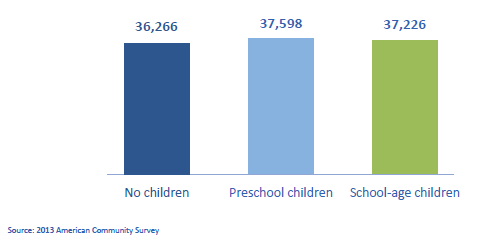When Do Mothers Earn More? A Look at Fertility Timing and Occupation
When Do Mothers Earn More? A Look at Fertility Timing and Occupation
Note: Census Bureau experts are presenting on a variety of topics at the Population Association of America annual conference. Follow the Research Matters blog or visit the press kit to learn more about their work.
Researchers have highlighted a consistent motherhood “wage penalty” of 6 to 7 percent for mothers of one child and 12 to 13 percent for mothers of multiple children. Another examination of the data, however, shows that there are certain circumstances where mothers outearn nonmothers.
Using data collected in the 2013 American Community Survey, I look at the earnings gap between mothers and nonmothers, and then examine how the earnings gap varies by occupation and age of children. My research shows that while mothers were more likely to be out of the labor force or work part time than nonmothers, mothers earned more than nonmothers among full-time, year-round workers. One explanation provided in prior research is that mothers with higher earnings potential may be more likely to remain employed full time.
Median earnings of women ages 18-50 employed full time, year-round, 2013

Fertility delay has been linked to higher earnings for mothers. The mean age at first birth in 2013 was 26 years old and a growing number of women are postponing children. When looking at earnings by age, we see that younger mothers earned less than nonmothers in the same age group, while older mothers earned more than nonmothers in the same age group. Mothers in the youngest age group, 18-29, experienced the largest earnings penalty relative to nonmothers. Mothers in the oldest age group, 40-50, experienced the largest earnings premium, particularly among mothers of preschool-age children (ages 0-5).
Median earnings by age of mother and age and presence of children, 2013

The earnings gap also varied by occupation. Mothers in the managerial and professional occupation group experienced the largest earnings penalties for young motherhood, but also the largest earnings premium for delayed fertility. In managerial and professional occupations, mothers of preschoolers earned $11,000 more than nonmothers of the same age if they had children between the ages of 40 and 50. Women in managerial and professional occupations with the earliest fertility, that is, mothers ages 18 to 29 with school-age children (ages 6 to 17), earned $9,000 less than nonmothers of the same age. Having children at older ages did not translate into an earnings premium for women in construction, production, agriculture, health care support, cleaning and maintenance, or food preparation, where mothers earned less than nonmothers or there is no statistical difference in their earnings.
Mothers earned more than nonmothers when they had children at older ages and they worked in managerial and professional, protective service or sales occupations. From an earnings point of view, delaying fertility (that is, putting off when they have their first child) may be particularly important for women in occupations requiring advanced degrees or longer tenure for career advancement, because younger mothers may never catch up to the earnings of women who wait to have children or who never have children. In other occupations, however, delaying fertility is not associated with higher earnings for mothers.
Earnings penalty or premium by occupation and age among mothers of preschool children, 2013*
The estimates presented are based on responses from a sample of the population. As with all surveys, estimates may vary from the actual values because of sampling variation or other factors. For information on confidentiality protection, sampling error, nonsampling error, and definitions, see: https://www.census.gov/acs/www/Downloads/data_documentation/Accuracy/ACS_Accuracy_of_Data_2013.pdf




